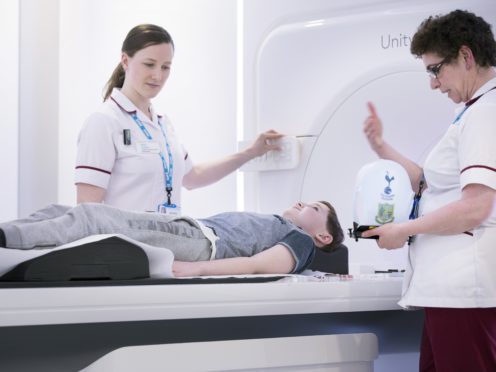
A young brain cancer patient has become the first child to test-drive a pioneering radiotherapy machine.
Alex Burchell, 13, volunteered to be scanned in the MR Linac machine at The Royal Marsden Hospital in Sutton, to help doctors prepare to treat children.
The hospital hopes to start administering radiotherapy to selected paediatric patients using the technology next year.

Scientists believe the machine, which is unique in generating magnetic resonance images (MRI) while also delivering X-ray radiation beams, could one day cure some cancers in a single treatment.
The technology can track the shifting positions of tumours in real time, allowing clinicians to constantly monitor their location while administering treatment.
Tottenham fan Alex, who was diagnosed with a high grade glioma brain tumour in January, helped the Royal Marsden team test and calibrate the machine’s imaging equipment earlier this month.
He did not undergo radiotherapy during the test-run, but full trials in paediatric patients with upper abdominal and high grade glioma are expected to begin in 2020.

Prostate cancer patient Barry Dolling, 65, became the first UK patient to receive the groundbreaking radiotherapy treatment in September last year.
Since then 12 others have been treated, and a new trial for rectal cancer patients opened last month.
Steve Burchell, from Surrey, said his son Alex “absolutely loves being scanned” and jumped at the chance to take part.
“He was only too happy to help the MR Linac team test the scanning part of the machine,” Mr Burchell said.
“It is great to think he is helping patients like him in the future be treated on this machine. I can’t quite believe he is the first child in the UK to go on a machine like this.”
Dr Henry Mandeville, consultant clinical oncologist at The Royal Marsden, said: “The advanced imaging of the MR Linac enables acquisition of high quality MR imaging prior to, during and after the delivery of radiotherapy.
“This imaging is far superior to that available for standard linear accelerators, or for proton therapy, and in the future has the potential to facilitate daily adaptation of radiotherapy plans, which would improve the accuracy of the radiotherapy delivery and look to reduce the exposure of adjacent organs at risk.
“It also means that there will be less exposure to radiation from imaging during radiotherapy too.”

Enjoy the convenience of having The Sunday Post delivered as a digital ePaper straight to your smartphone, tablet or computer.
Subscribe for only £5.49 a month and enjoy all the benefits of the printed paper as a digital replica.
Subscribe